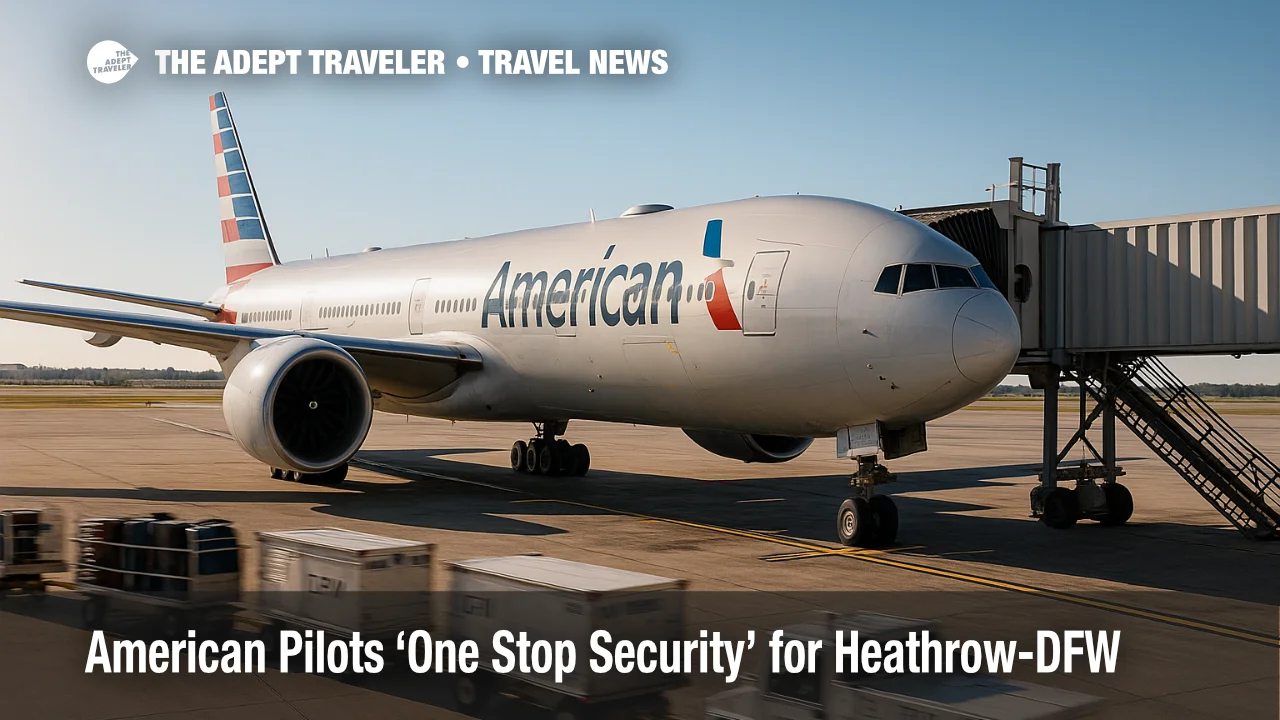American Pilots 'One Stop Security' for Heathrow-DFW

American Airlines has begun testing "One Stop Security," a first-of-its-kind program that lets travelers arriving from London Heathrow clear U.S. Customs at their Dallas Fort Worth arrival gate. Passengers connecting onward can skip baggage re-check and the TSA checkpoint, cutting minimum connection times by more than half, according to the carrier. The pilot, developed with TSA, U.S. Customs and Border Protection, and the U.K. Department for Transport, relies on BagCheck and Brock Solutions technology to tag, screen, and transfer checked bags without additional traveler touchpoints.
Key Points
- Why it matters: Connection times fall from roughly 90 minutes to about 40.
- Gate-side Customs replaces the re-check carousel.
- TSA rescreening is no longer required for eligible passengers.
- Checked bags travel automatically to the next flight.
- American says expansion to other hubs is under review.
Snapshot
One Stop Security applies to customers flying American flight 51 from London Heathrow (LHR) to Dallas Fort Worth (DFW) who hold a same-day onward ticket on American or an interline partner. After U.S. border officers verify passports at the jet bridge, travelers walk straight into the sterile concourse. Behind the scenes, RFID-tagged luggage enters a secure corridor where TSA explosives-trace devices and CT scanners vet each bag before it is routed to the domestic belt. American says the scheme preserves existing security layers while giving travelers extra buffer against missed connections and tight layovers.
Background
International passengers normally queue at passport control, claim bags, clear Customs, re-deposit luggage, then repeat TSA screening-steps that can consume more than an hour at busy U.S. hubs. Pre-clearance facilities in Canada, Ireland, and a handful of Caribbean airports tackle the problem on the departure side, but those require dedicated space overseas. One Stop Security flips the model by moving U.S. officers to the jet bridge and automating bag transfers on-site at a U.S. gateway, using DFW's existing sterile corridors built for international-to-domestic flows. The concept aligns with TSA's broader modernization drive that recently ended the 19-year shoe-removal rule, giving flyers another time-saving win. Read our earlier coverage of the shoe policy change here.
Latest Developments
Pilot Route Details
The trial currently covers a single daily flight, AA 51, operated by a Boeing 777-300ER. Eligible customers include U.S. citizens, lawful permanent residents, and foreign nationals with valid documents. Travelers booked in transit for less than eight hours are automatically enrolled; no extra fee applies. American plans to study data for several months before pitching additional Heathrow departures into hubs such as Miami, Charlotte, and Chicago O'Hare.
Regulatory Support and Next Steps
TSA and CBP officials call the Dallas test a "commonsense evolution" that dovetails with Seamless Border Entry facial-recognition trials now running at JFK and LAX. Agency spokespeople say lessons from DFW will inform nationwide standards aimed at scaling One Stop Security to airports that already separate arriving and departing flows. American executives hope a successful rollout will encourage rival carriers and alliance partners to adopt compatible systems, smoothing interline transfers across networks.
Analysis
For travelers, the immediate benefit is predictability. Heathrow-DFW ranks among the busiest transatlantic corridors, funneling customers to more than 200 U.S. and Latin American destinations. Eliminating the "re-check shuffle" gives families extra time to reach distant gates and grants business flyers a larger margin for weather or ramp delays. Operationally, Dallas gains throughput: fewer passengers crowd the re-inspection hall, and TSA lanes handle mainly origin traffic, easing peak piles. The program also showcases how RFID and computer-vision bag-scanning can plug gaps left by traditional bar-code sorting. Competitors are watching closely. Delta is reportedly eyeing an Atlanta test, while United's Houston hub already has the sterile-corridor infrastructure but lacks gate-side Customs staff. If pilots prove reliable, One Stop Security could accelerate a shift toward biometric, risk-based screening-an evolution regulators hinted at when they scrapped mandatory shoe removal. Wider adoption will hinge on funding, staffing, and harmonizing data standards between airlines, airports, and security agencies.
Final Thoughts
American's One Stop Security program may mark the biggest rethink of post-9/11 connecting procedures in two decades. By merging border control, baggage handling, and TSA checks into a single, invisible layer, the airline aims to turn complex U.S. gateways into true one-stop transfers. If the Heathrow-DFW pilot proves durable, travelers could soon see the One Stop Security program on multiple routes worldwide, reshaping expectations for international connections.
